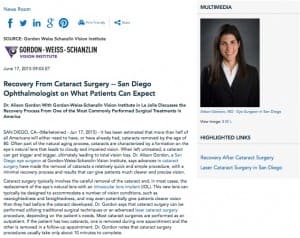
Dr. Alison Gordon with Gordon Schanzlin New Vision Institute Institute in La Jolla discusses the recovery process from one of the most commonly performed surgical treatments in America.
San Diego, CA – It has been estimated that more than half of all Americans will either need to have, or have already had, cataracts removed by the age of 80. Often part of the natural aging process, cataracts are characterized by a formation on the eye’s natural lens that leads to cloudy and impaired vision. When left untreated, a cataract can get bigger and bigger, ultimately leading to total vision loss. Dr. Alison Gordon, a San Diego eye surgeon at Gordon Schanzlin New Vision Institute Institute, says advances in cataract surgery have made the removal of cataracts a relatively quick and simple procedure, with a minimal recovery process and results that can give patients much clearer and precise vision.
Cataract surgery typically involves the careful removal of the cataract and, in most cases, the replacement of the eye’s natural lens with an intraocular lens implant (IOL). This new lens can typically be designed to accommodate a number of vision conditions, such as nearsightedness and farsightedness, and may even potentially give patients clearer vision than they had before the cataract developed. Dr. Gordon says that cataract surgery can be performed utilizing traditional surgical techniques or an advanced laser cataract surgery procedure, depending on the patient’s needs. Most cataract surgeries are performed as an outpatient. If the patient has two cataracts, one is removed during one appointment and the other is removed in a follow-up appointment. Dr. Gordon notes that cataract surgery procedures usually take only about 10 minutes to complete.
In terms of recovery and aftercare for cataract surgery, Dr. Gordon says, for most patients, this process is relatively uneventful. “Patients need to use eyedrops – usually three different kinds of prescription drops for varying amounts of time – anywhere from one week to about six weeks. Vision will be a little blurry initially – patients will need someone to drive them to their first visit.” Dr. Gordon says one thing patients should be aware of is that some degree of vision fluctuation during the recovery process can be expected. “Try and be patient. Don’t be alarmed if you have some fluctuation with vision, it’s normal for healing to take a little time; however, if you start having an increase in pain or a sharp drop in vision, you should definitely contact [your doctor] and explain what’s going on.”
Patients are advised to avoid lifting heavy objects, bending over to the point where blood is rushing to the head, and strenuous activities or swimming for two weeks after cataract surgery; however, Dr. Gordon says, recovery is often fairly easy for many patients. “Assuming the healing process goes well, cataract patients can typically start driving again the next day and return to work the next day as well. Other than [the standard restrictions], patients can travel on airplanes and do most everything else during the recovery process.”
Dr. Gordon says one of the best things individuals can do to make sure cataracts do not progressively steal their sight is to be sure to have regular eye exams. She also notes that people should be aware of the symptoms of cataracts, which include: cloudy, blurry, or dull vision; light sensitivity; a “halo” effect around lights; ghost images; double-vision; a fading effect on colors; and frequent changes in eyewear prescriptions. Dr. Gordon says the earlier diagnosis and treatment is performed, the greater the chance that cataracts can be successfully removed and the risk of complete vision loss dramatically reduced.
About Dr. Alison Gordon
Dr. Alison Gordon is a member of the American Academy of Ophthalmology, the American Medical Association, and the Unite for Sight Organization. She is a magna cum laude graduate from Princeton University and earned her medical degree from the Mount Sinai School of Medicine in New York. Dr. Gordon completed her ophthalmology residency at California Pacific Medical Center in San Francisco. At Gordon Schanzlin New Vision Institute Institute, Dr. Gordon performs procedures including cataract surgery and LASIK laser vision correction treatments. She is also experienced with glaucoma management, treatment and management of corneal disease, and general eye care procedures. Dr. Gordon is available for interview upon request.
For more information, please visit gwsvision.com and facebook.com/lasiksandiego.
Contact:
Gordon Schanzlin New Vision Institute Institute
8910 University Center Lane
Ste. 800
La Jolla, San Diego, CA 92122
(858) 455-6800

